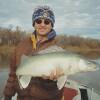Here's what I think about hunting for morel mushrooms in the spring:
It’s a lot like muskie fishing.
ADVERTISEMENT

“That’s crazy,” you say?
Perhaps, but hear me out.
Over my many years of covering the Great Outdoors, I’ve heard numerous stories of anglers hooking into big muskies when they’re not actually fishing for them.
Instead of slinging big lures for countless hours in hopes of just seeing a fish, they’re dunking a jig and a minnow or trolling a spinner-nightcrawler rig, when they hook into the mythical “Fish of 10,000 Casts.”
Without even trying.
Such was the case in July 2019, when two friends and I spent a weekend on the Ontario side of Lake of the Woods. Seeking a break from reeling and dropping big jigs repeatedly into 90 feet of water, we decided to check out a shallow bay and pitch jigs and soft plastics, in hopes of catching a few bass or maybe a walleye.
One of my buddies was playing a largemouth bass when his line suddenly stopped and started peeling off his reel. We saw why a short time later; a muskie had latched on to the bass.
ADVERTISEMENT
We scrambled to land the two fish, but the net wasn’t big enough. In the gong show that ensued, the muskie decided it had had enough and released its grip on the largemouth, which was considerably worse for wear.
The muskie, we guessed, was in the low- to mid-40-inch range. Not a monster by muskie standards, but impressive just the same.
Had we actually been fishing for muskies, we likely wouldn’t have even seen that fish.
I thought about that encounter again last weekend while checking my usual springtime “milk route” for wild asparagus. Once established, wild asparagus grows in the same places every spring, but the prime picking window isn’t open very long. Time it right, and it’s not unusual – at least in my experience – to fill a small grocery bag in short order.
I absolutely love wild asparagus.
It grows amazingly fast, though, so timing is everything. Asparagus that’s too small to pick can be 3 feet tall just days later. At that point, it’s chewy and fibrous, not crisp and juicy like asparagus in its prime.
I wasn’t looking for morels last weekend on my asparagus hunt, but there they were – gorgeous black morels, a half dozen of them in their prime – in a spot where I’d never seen them before.
ADVERTISEMENT
Odd though it may seem, I get the same rush when I find a morel as when I spot a ruffed grouse in the woods or see a nice fish appear from the depths at the end of my line.
It’s pure excitement. And they never fly or swim away.
Hoping the unexpected morel discovery was a sign of more to come, I put in a serious effort to look for them the next morning in a spot that produced morels in abundance last year about this time. I put on a couple of miles in the process, and while I managed to scrounge a dozen or so yellow morels, it didn’t compare with the unexpected encounter I had the previous afternoon.
I couldn’t be disappointed, though. During my foraging foray, I heard three or four ruffed grouse drumming and an abundance of songbirds, including American goldfinch, great-crested flycatcher, Nashville warbler, song sparrow, least flycatcher, chestnut-sided warbler, common yellowthroat, veery thrush, magnolia warbler and ovenbird.
That’s according to my Merlin app, at least. I’m a novice when it comes to bird sounds – so be nice, all you birders out there, if that list seems wrong – but I thought it was an impressive list, based on the relatively small area where I heard them.
It was a rewarding hike in the woods.
The morels may not be in abundance like last year in the places I look, but that’s not surprising, based on my internet research. Here’s what ChatGPT had to say:
ADVERTISEMENT
“Morels can be famously fickle. In short, morels are like wild gold … their unpredictability is part of the fun (and frustration) of hunting them.”
Just like muskie fishing.










